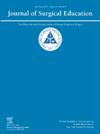机器人手术培训中的住院医师手术自主权:解读性别差异和培训趋势。
IF 2.6
3区 医学
Q1 EDUCATION, SCIENTIFIC DISCIPLINES
引用次数: 0
摘要
目的本研究评估了与本院住院医师报告的机器人手术自主性相关的住院医师和项目层面的因素:这项回顾性队列研究评估了住院医师自我报告的机器人手术病例日志,其中详细记录了病例类型、控制台时间和已完成的部分。分析包括三种手术:胰十二指肠切除术、疝修补术和低位前路切除术。每个手术分为四个关键部分。衡量的结果包括在控制台的工作时间和高住院医师自主性(HRA),定义为住院医师病例参与率>50%。独立变量包括毕业队列、攻读的奖学金类型、主治医生性别、少数族裔代表不足情况和医院类型。研究进行了单变量和多变量逻辑回归:本研究于 2021 年至 2023 年期间在德克萨斯大学西南医学中心普通外科住院医师培训中心进行:29名住院总医师(研究生5年级):在541个病例中,61%为疝修补术,26%为低位前路切除术,13%为胰十二指肠切除术。女性住院医师占 60%。男性住院医师报告了更多的 HRA(76% 对 54%)和更长的控制台时间(150 分钟对 120 分钟;P < 0.01)。多变量分析表明,与男性相比,女性发生 HRA 的几率低 74% (95% CI:0.15 - 0.45;p < 0.001),控制台时间少 18 分钟(p < 0.01)。2023年组群的住院医师发生HRA的几率明显高于2021年组群(OR:4.46,95% CI:2.34 - 8.51;p < 0.001),控制台时间多出15分钟。获得对齐研究金的住院医师比未获得研究金的住院医师多花费 37 分钟的控制台时间(P < 0.001)。主治医生的性别、医院和少数民族身份之间没有明显差异:我们的研究结果表明,在自我报告的手术自主权和控制台时间方面存在明显的性别差异。最近的队列显示培训结果有所改善,研究员与病例的一致性对控制台时间产生了积极影响。这表明有必要改进培训方法,确保公平并优化培训效果。本文章由计算机程序翻译,如有差异,请以英文原文为准。
Resident Operative Autonomy in Robotic Surgery Training: Unpacking Gender Disparities and Training Trends
OBJECTIVE
This study evaluated resident and program-level factors associated with resident-reported robotic operative autonomy at our institution.
DESIGN
This retrospective cohort study evaluates self-reported residents’ robotic case logs detailing case type, console time, and portions of the case completed. The analysis included three procedures: pancreaticoduodenectomies, hernia repairs, and low anterior resection. Each procedure was divided into four key portions. Outcomes measured included minutes at the console and High Resident Autonomy (HRA), defined as >50% resident case participation. Independent variables included graduation cohort, pursued fellowship type, attending gender, underrepresented minority status, and hospital type. Univariable and multivariable logistic regression were performed.
SETTING
This study took place at the University of Texas Southwestern Medical Center General Surgery Residency between 2021 and 2023.
PARTICIPANTS
Twenty-nine chief residents (postgraduate year 5).
RESULTS
Of the 541 cases, 61% were hernia repairs, 26% were low anterior resections, and 13% were pancreaticoduodenectomies. Female residents were present in 60% of the cases. Male residents reported more HRA (76% vs. 54%) and longer console times (150 vs 120 minutes; p < 0.01). Multivariable analysis indicated female gender was associated with 74% lower odds of HRA (95% CI: 0.15 - 0.45; p < 0.001) and 18 fewer minutes of console time versus males (p < 0.01). The 2023 cohort had significantly higher odds of HRA than the 2021 cohort (OR: 4.46, 95% CI: 2.34 - 8.51; p < 0.001) and 15 more console minutes. Residents with aligned fellowships spent 37 more console minutes than those without (p < 0.001). No significant differences were found between attending gender, hospital, and minority status.
CONCLUSIONS
Our findings reveal significant gender disparities in self-reported operative autonomy and console time. The recent cohort showed improved training outcomes, and fellowship alignment with the case positively impacted console time. This suggests a need to refine training approaches, ensuring equity and optimizing training efficacy.
求助全文
通过发布文献求助,成功后即可免费获取论文全文。
去求助
来源期刊

Journal of Surgical Education
EDUCATION, SCIENTIFIC DISCIPLINES-SURGERY
CiteScore
5.60
自引率
10.30%
发文量
261
审稿时长
48 days
期刊介绍:
The Journal of Surgical Education (JSE) is dedicated to advancing the field of surgical education through original research. The journal publishes research articles in all surgical disciplines on topics relative to the education of surgical students, residents, and fellows, as well as practicing surgeons. Our readers look to JSE for timely, innovative research findings from the international surgical education community. As the official journal of the Association of Program Directors in Surgery (APDS), JSE publishes the proceedings of the annual APDS meeting held during Surgery Education Week.
 求助内容:
求助内容: 应助结果提醒方式:
应助结果提醒方式:


